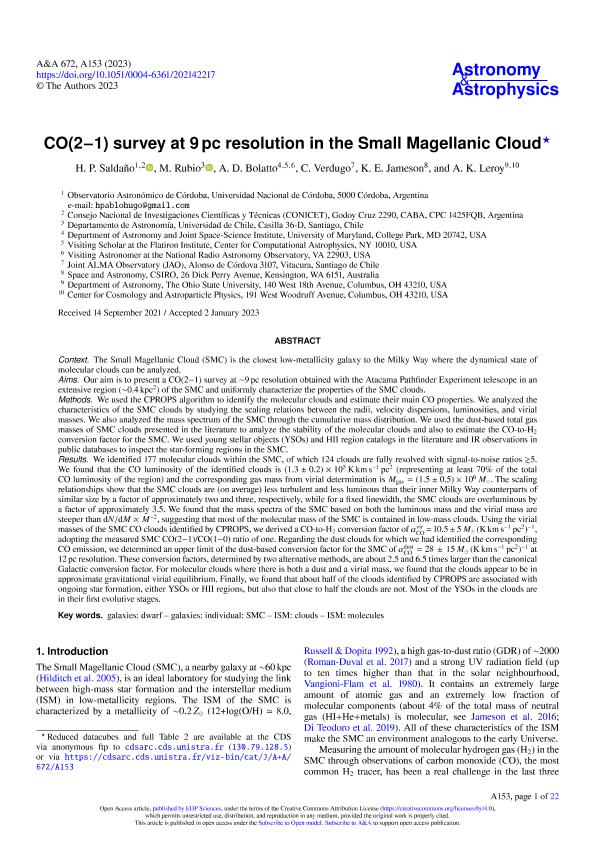Mostrar el registro sencillo del ítem
dc.contributor.author
Saldaño, Hugo Pablo

dc.contributor.author
Rubio, M.
dc.contributor.author
Bolatto, A. D.
dc.contributor.author
Verdugo, C.
dc.contributor.author
Jameson, K. E.
dc.contributor.author
Leroy, A. K.
dc.date.available
2024-04-15T15:45:25Z
dc.date.issued
2023-04
dc.identifier.citation
Saldaño, Hugo Pablo; Rubio, M.; Bolatto, A. D.; Verdugo, C.; Jameson, K. E.; et al.; CO(2-1) survey at 9 pc resolution in the Small Magellanic Cloud; EDP Sciences; Astronomy and Astrophysics; 672; 4-2023; 1-22
dc.identifier.issn
0004-6361
dc.identifier.uri
http://hdl.handle.net/11336/233026
dc.description.abstract
Context. The Small Magellanic Cloud (SMC) is the closest low-metallicity galaxy to the Milky Way where the dynamical state of molecular clouds can be analyzed. Aims. Our aim is to present a CO(2-1) survey at ~9 pc resolution obtained with the Atacama Pathfinder Experiment telescope in an extensive region (~0.4kpc2) of the SMC and uniformly characterize the properties of the SMC clouds. Methods. We used the CPROPS algorithm to identify the molecular clouds and estimate their main CO properties. We analyzed the characteristics of the SMC clouds by studying the scaling relations between the radii, velocity dispersions, luminosities, and virial masses. We also analyzed the mass spectrum of the SMC through the cumulative mass distribution. We used the dust-based total gas masses of SMC clouds presented in the literature to analyze the stability of the molecular clouds and also to estimate the CO-to-H2 conversion factor for the SMC. We used young stellar objects (YSOs) and HII region catalogs in the literature and IR observations in public databases to inspect the star-forming regions in the SMC. Results. We identified 177 molecular clouds within the SMC, of which 124 clouds are fully resolved with signal-to-noise ratios ≲5. We found that the CO luminosity of the identified clouds is (1.3 ± 0.2) ×105 K kms-1 pc2 (representing at least 70% of the total CO luminosity of the region) and the corresponding gas mass from virial determination is Mgas = (1.5 ± 0.5) ×106 M⊙. The scaling relationships show that the SMC clouds are (on average) less turbulent and less luminous than their inner Milky Way counterparts of similar size by a factor of approximately two and three, respectively, while for a fixed linewidth, the SMC clouds are overluminous by a factor of approximately 3.5. We found that the mass spectra of the SMC based on both the luminous mass and the virial mass are steeper than dN/dM αM-2, suggesting that most of the molecular mass of the SMC is contained in low-mass clouds. Using the virial masses of the SMC CO clouds identified by CPROPS, we derived a CO-to-H2 conversion factor of αCOvir = 10.5 ± 5 M⊙ (K km s-1 pc2)-1, adopting the measured SMC CO(2-1)/CO(1-0) ratio of one. Regarding the dust clouds for which we had identified the corresponding CO emission, we determined an upper limit of the dust-based conversion factor for the SMC of αCOdust = 28 ± 15 M⊙ (Kkm s-1 pc2)-1 at 12 pc resolution. These conversion factors, determined by two alternative methods, are about 2.5 and 6.5 times larger than the canonical Galactic conversion factor. For molecular clouds where there is both a dust and a virial mass, we found that the clouds appear to be in approximate gravitational virial equilibrium. Finally, we found that about half of the clouds identified by CPROPS are associated with ongoing star formation, either YSOs or HII regions, but also that close to half the clouds are not. Most of the YSOs in the clouds are in their first evolutive stages.
dc.format
application/pdf
dc.language.iso
eng
dc.publisher
EDP Sciences

dc.rights
info:eu-repo/semantics/openAccess
dc.rights.uri
https://creativecommons.org/licenses/by-nc-sa/2.5/ar/
dc.subject
GALAXIES: DWARF
dc.subject
GALAXIES: INDIVIDUAL: SMC
dc.subject
ISM: CLOUDS
dc.subject
ISM: MOLECULES
dc.subject.classification
Astronomía

dc.subject.classification
Ciencias Físicas

dc.subject.classification
CIENCIAS NATURALES Y EXACTAS

dc.title
CO(2-1) survey at 9 pc resolution in the Small Magellanic Cloud
dc.type
info:eu-repo/semantics/article
dc.type
info:ar-repo/semantics/artículo
dc.type
info:eu-repo/semantics/publishedVersion
dc.date.updated
2024-04-15T15:33:48Z
dc.identifier.eissn
1432-0746
dc.journal.volume
672
dc.journal.pagination
1-22
dc.journal.pais
Francia

dc.description.fil
Fil: Saldaño, Hugo Pablo. Universidad Nacional de Córdoba. Observatorio Astronómico de Córdoba; Argentina. Consejo Nacional de Investigaciones Científicas y Técnicas. Centro Científico Tecnológico Conicet - Salta. Instituto de Investigaciones en Energía no Convencional. Universidad Nacional de Salta. Facultad de Ciencias Exactas. Departamento de Física. Instituto de Investigaciones en Energía no Convencional; Argentina
dc.description.fil
Fil: Rubio, M.. Universidad de Chile; Chile
dc.description.fil
Fil: Bolatto, A. D.. University of Maryland; Estados Unidos. National Radio Astronomy Observatory; Estados Unidos
dc.description.fil
Fil: Verdugo, C.. No especifíca;
dc.description.fil
Fil: Jameson, K. E.. No especifíca;
dc.description.fil
Fil: Leroy, A. K.. Ohio State University; Estados Unidos
dc.journal.title
Astronomy and Astrophysics

dc.relation.alternativeid
info:eu-repo/semantics/altIdentifier/doi/http://dx.doi.org/10.1051/0004-6361/202142217
dc.relation.alternativeid
info:eu-repo/semantics/altIdentifier/doi/https://doi.org/10.1051/0004-6361/202142217
Archivos asociados
